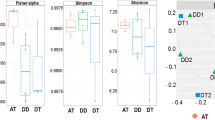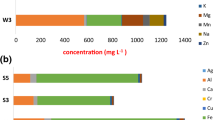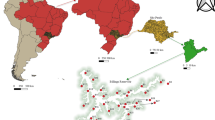Abstract
Depletion of oxygen in certain marine areas creates oxygen minimum zones (OMZs), which can alter the species composition and abundance. We have carried out high-throughput 16S rRNA gene amplicon profiling from the Bay of Bengal (BOB) OMZ and non-OMZ areas. Typically, a total of 35 families of micro-organisms were identified as biomarkers for OMZ and non-OMZ regions in the BOB. Our analysis has identified families Pseudoalteromonadaceae, OM60 and Synechococcaceae to be abundant in oxygenated water, whereas organisms belonging to families Pelagibacteraceae and Caulobacteraceae, which are involved in sulphur and nitrogen metabolism, were prominent in the OMZ areas. Predictive functional analysis for these identified bacteria clearly that suggested an abundance of microbes with assimilatory sulphur-reducing genes (cysl and csH) in the non-OMZ, while bacteria involved in dissimilatory sulphate reduction (known to carry aprA and aprB genes) were enriched in the OMZ areas. Comparative analysis with OMZ areas from Peru and Chile revealed that OMZ areas in the BOB are characterized by specific and distinctive bacterial diversity. Overall, the current analysis provides valuable documentation about the bacterial populations and their characteristics, which can generate pointers for their functional significance in the BOB.






Similar content being viewed by others
References
Abraham W-R, Rohde M and Bennasar A 2014 The family Caulobacteraceae; in Rosenberg E, DeLong EF, Lory S, Stackebrandt E and Thompson F (eds) The Prokaryotes (Springer, Berlin, Heidelberg) pp 179–205
Anas A, Nilayangod C, Jasmin C, Vinothkumar S, Parameswaran PS and Nair S 2016 Diversity and bioactive potentials of culturable heterotrophic bacteria from the surficial sediments of the Arabian Sea. 3 Biotech 6 238
Arrigo KR 2005 Marine microorganisms and global nutrient cycles. Nature 437 349–355
Cao H, Dong C, Bougouffa S, Li J, Zhang W, Shao Z, et al. 2016 Delta-proteobacterial SAR324 group in hydrothermal plumes on the South Mid-Atlantic Ridge. Sci. Rep. 6 22842
Chorus I and Bartram J 1999 Toxic cyanobacteria in water: a guide to their public health consequences, monitoring and management (F & FN Spon)
Das S, De M, De TK, Ray R, Jana TK, Ghosh PK and Maiti TK 2012a Distribution of aerobic and anaerobic bacteria along the intertidal zones of Sunderban mangrove ecosystems, NE coast of Bay of Bengal, West Bengal, India. Indian J. Geo-Mar. Sci. 41 405
Das S, De M, Ray R, Chowdhury C, Jana TK and De TK 2012b Microbial ecosystem in Sunderban mangrove forest sediment, North-East coast of Bay of Bengal, India. Geomicrobiol. J. 29 656–666
Das S, Lyla PS and Khan SA 2007 Spatial variation of aerobic culturable heterotrophic bacterial population in sediments of the continental slope of western Bay of Bengal. Indian J. Mar. Sci. 36 51–58
Dash HR and Das S 2016 Diversity, community structure, and bioremediation potential of mercury-resistant marine bacteria of estuarine and coastal environments of Odisha, India. Environ. Sci. Pollut. Res. 23 6960–6971
De J, Sarkar A and Ramaiah N 2006 Bioremediation of toxic substances by mercury resistant marine bacteria. Ecotoxicology 15 385–389
Divya B, Parvathi A, Bharathi PL and Nair S 2011 16S rRNA-based bacterial diversity in the organic-rich sediments underlying oxygen-deficient waters of the eastern Arabian Sea. World J. Microbiol. Biotechnol. 27 2821–2833
Divya B, Soumya KV and Nair S 2010 16SrRNA and enzymatic diversity of culturable bacteria from the sediments of oxygen minimum zone in the Arabian Sea. Antonie Van Leeuwenhoek 98 9–18
Falkowski PG, Fenchel T and Delong EF 2008 The microbial engines that drive Earth’s biogeochemical cycles. Science 320 1034–1039
Ghosh A, Dey N, Bera A, Tiwari A, Sathyaniranjan KB, Chakrabarti K and Chattopadhyay D 2010 Culture independent molecular analysis of bacterial communities in the mangrove sediment of Sundarban, India. Saline Syst. 6 1
Glaubitz S, Kießlich K, Meeske C, Labrenz M and Jürgens K 2013 SUP05 dominates the gammaproteobacterial sulfur oxidizer assemblages in pelagic redoxclines of the central Baltic and Black Seas. Appl. Environ. Microbiol. 79 2767–2776
Hammer Ø, Harper DAT and Ryan PD 2001 PAST: paleontological statistics software package for education and data analysis. Palaeontolia Electronica 4 9
Helly JJ and Levin LA 2004 Global distribution of naturally occurring marine hypoxia on continental margins. Deep Sea Res. Part Oceanogr. Res. Pap. 51 1159–1168
Jayakumar DA, Naqvi SWA, Narvekar PV and George MD 2001 Methane in coastal and offshore waters of the Arabian Sea. Mar. Chem. 74 1–13
Johnston DT, Wolfe-Simon F, Pearson A and Knoll AH 2009 Anoxygenic photosynthesis modulated Proterozoic oxygen and sustained Earth’s middle age. Proc. Natl. Acad. Sci. 106 16925–16929
Kamykowski D and Zentara S-J 1990 Hypoxia in the world ocean as recorded in the historical data set. Deep Sea Res. Part Oceanogr. Res. Pap. 37 1861–1874
Kanehisa M and Goto S 2000 KEGG: Kyoto encyclopedia of genes and genomes. Nucleic Acids Res. 28 27–30
Kanehisa M, Goto S, Sato Y, Kawashima M, Furumichi M and Tanabe M 2014 Data, information, knowledge and principle: back to metabolism in KEGG. Nucleic Acids Res. 42 D199–D205
Kibria G, Hossain MM, Mallick D, Lau TC and Wu R 2016 Monitoring of metal pollution in waterways across Bangladesh and ecological and public health implications of pollution. Chemosphere 165 1–9
Komarek J, Kastovsky J, Mares J and Johansen JR 2014 Taxonomic classification of cyanoprokaryotes cyanobacterial genera 2014, using a polyphasic approach. Preslia 86 295–335
Lam P and Kuypers MM 2011 Microbial nitrogen cycling processes in oxygen minimum zones. Annu. Rev. Mar. Sci. 3 317–345
Lam P, Lavik G, Jensen MM, van de Vossenberg J, Schmid M, Woebken D, et al. 2009 Revising the nitrogen cycle in the Peruvian oxygen minimum zone. Proc. Natl. Acad. Sci. 106 4752–4757
Langille MG, Zaneveld J, Caporaso JG, McDonald D, Knights D, Reyes JA, et al. 2013 Predictive functional profiling of microbial communities using 16S rRNA marker gene sequences. Nat. Biotechnol. 31 814–821
Lüke C, Speth DR, Kox MA, Villanueva L and Jetten MS 2016a Metagenomic analysis of nitrogen and methane cycling in the Arabian Sea oxygen minimum zone. PeerJ 4 e1924
Lüke C, Speth DR, Kox MA, Villanueva L and Jetten MS 2016b Metagenomic analysis of nitrogen and methane cycling in the Arabian Sea oxygen minimum zone. PeerJ 4 e1924
Mahalakshmi N and Jayalakshmi S 2016 Amylase, cellulase and xylanase production from a novel bacterial isolate Achromobacter xylosoxidans isolated from marine environment. Int. J. Adv. Res. Biol. Sci. 3 230–233
Maltby J, Sommer S, Dale AW and Treude T 2016 Microbial methanogenesis in the sulfate-reducing zone of surface sediments traversing the Peruvian margin. Biogeosciences 13 283–299
Markowitz VM, Chen I-MA, Palaniappan K, Chu K, Szeto E, Grechkin Y, et al. 2012 IMG: the integrated microbial genomes database and comparative analysis system. Nucleic Acids Res. 40 D115–D122
Milliman JD and Meade RH 1983 World-wide delivery of river sediment to the oceans. J. Geol. 91 1–21
Milliman JD and Syvitski JP 1992 Geomorphic/tectonic control of sediment discharge to the ocean: the importance of small mountainous rivers. J. Geol. 100 525–544
Morris RM, Rappé MS, Connon SA, Vergin KL, Siebold WA, Carlson CA and Giovannoni SJ 2002 SAR11 clade dominates ocean surface bacterioplankton communities. Nature 420 806–810
Naqvi SWA, Naik H, Pratihary A, et al. 2006 Coastal versus open-ocean denitrification in the Arabian Sea. Biogeosciences 3 621–633
Newton RJ, Huse SM, Morrison HG, Peake CS, Sogin ML and McLellan SL 2013 Shifts in the microbial community composition of Gulf Coast beaches following beach oiling. PloS One 8 e74265
Nithya C and Pandian SK 2010 Isolation of heterotrophic bacteria from Palk Bay sediments showing heavy metal tolerance and antibiotic production. Microbiol. Res. 165 578–593
Ortmann AC and Santos TT 2016 Spatial and temporal patterns in the Pelagibacteraceae across an estuarine gradient. FEMS Microbiol. Ecol. 92 fiw133
Parks DH, Tyson GW, Hugenholtz P and Beiko RG 2014 STAMP: statistical analysis of taxonomic and functional profiles. Bioinformatics 30 3123–3124
Pramanik A, Basak P, Banerjee S, Sengupta S, Chattopadhyay D and Bhattacharyya M 2016 Metagenomic exploration of the bacterial community structure at Paradip Port, Odisha, India. Genomics Data 7 94–96
Prasanna Kumar S, Muraleedharan PM, Prasad TG, Gauns M, Ramaiah N, De Souza SN, et al. 2002 Why is the Bay of Bengal less productive during summer monsoon compared to the Arabian Sea? Geophys. Res. Lett. 29 88-1–88-4
Prasanna Kumar S, Nuncio M, Narvekar J, Kumar A, Sardesai S, De Souza SN, et al. 2004 Are eddies nature’s trigger to enhance biological productivity in the Bay of Bengal? Geophys. Res. Lett. https://doi.org/10.1029/2003GL019274
Rabalais NN, Diaz RJ, Levin LA, Turner RE, Gilbert D and Zhang J 2010 Dynamics and distribution of natural and human-caused hypoxia. Biogeosciences 7 585–619
Ramaiah N, Raghukumar S and Gauns M 1996 Bacterial abundance and production in the central and eastern Arabian Sea. Current Sci. 71 878–882
Ramaiah NV, Rodrigues V, Alwares E, Rodrigues C, Baksh R, Jayan S and Mohandass C 2007 Sewage-pollution indicator bacteria; in Shetye SR, Dileep Kumar M and Shankar D (eds) The Mandovi and Zuari estuaries (National Institute of Oceanography, Goa) pp 115–120. http://citeseerx.ist.psu.edu/viewdoc/download?doi=10.1.1.578.5036&rep=rep1&type=pdf
Ramesh S, Jayaprakashvel M and Mathivanan N 2006 Microbial status in seawater and coastal sediments during pre- and post-tsunami periods in the Bay of Bengal, India. Mar. Ecol. 27 198–203
Rixen T, Ramaswamy V, Gaye B, Herunadi B, Maier-Reimer E, Bange HW and Ittekkot V 2009 Monsoonal and ENSO impacts on particle fluxes and the biological pump in the Indian Ocean; in Wiggert JD, Hood RR, Wajih S, Naqvi A, Brink KH and Smith SL (eds) Indian Ocean Biogeochem. Process. Ecol. Var. (American Geophysical Union, Washington, D. C) pp 365–383
Ruban P and Gunaseelan C 2011 Antibiotic resistance of bacteria from Krishna Godavari Basin, Bay of Bengal, India. Environ. Exp. Biol. 9 33–136
Santhiya G, Lakshumanan C, Selvin J and Asha D 2011 Microbiological analysis of seawater and sediments in urban shorelines: occurrence of heavy metals resistance bacteria on Chennai beaches, Bay of Bengal. Microchem. J. 99 197–202
Satomi M and Fujii T 2014 The Family Oceanospirillaceae; in Rosenberg E, DeLong EF, Lory S, Stackebrandt E and Thompson F (eds) The Prokaryotes (Springer, Berlin, Heidelberg) pp 491–527
Segata N, Izard J, Waldron L, Gevers D, Miropolsky L, Garrett WS and Huttenhower C 2011 Metagenomic biomarker discovery and explanation. Genome Biol. 12 1
Selvin J, Priya SS, Kiran GS, Thangavelu T and Bai NS 2009 Sponge-associated marine bacteria as indicators of heavy metal pollution. Microbiol. Res. 164 352–363
Shah V, Chang BX and Morris RM 2016 Cultivation of a chemoautotroph from the SUP05 clade of marine bacteria that produces nitrite and consumes ammonium. ISME J. 11 263–271
Sheik CS, Jain S and Dick GJ 2014 Metabolic flexibility of enigmatic SAR324 revealed through metagenomics and metatranscriptomics. Environ. Microbiol. 16 304–317
Spring S, Riedel T, Spröer C, Yan S, Harder J and Fuchs BM 2013 Taxonomy and evolution of bacteriochlorophyll a-containing members of the OM60/NOR5 clade of marine gammaproteobacteria: description of Luminiphilus syltensis gen. nov., sp. nov., reclassification of Haliea rubra as Pseudohaliea rubra gen. nov., comb. nov., and emendation of Chromatocurvus halotolerans. BMC Microbiol. 13 1
Stramma L, Johnson GC, Sprintall J and Mohrholz V 2008 Expanding oxygen-minimum zones in the tropical oceans. Science 320 655–658
Ulloa O, Canfield DE, DeLong EF, Letelier RM and Stewart FJ 2012 Microbial oceanography of anoxic oxygen minimum zones. Proc. Natl. Acad. Sci. 109 15996–16003
Walsh EA, Kirkpatrick JB, Pockalny R, Sauvage J, Spivack AJ, Murray RW, et al. 2016 Relationship of bacterial richness to organic degradation rate and sediment age in subseafloor sediment. Appl. Environ. Microbiol. 82 4994–4999
Wang J, Kan J, Borecki L, Zhang X, Wang D and Sun J 2016 A snapshot on spatial and vertical distribution of bacterial communities in the eastern Indian Ocean. Acta Oceanol. Sin. 35 85–93
Ward BB, Devol AH, Rich JJ, Chang BX, Bulow SE, Naik H, et al. 2009 Denitrification as the dominant nitrogen loss process in the Arabian Sea. Nature 461 78–81
Whitman WB, Coleman DC and Wiebe WJ 1998 Prokaryotes: the unseen majority. Proc. Natl. Acad. Sci. 95 6578–6583
Woebken D, Lam P, Kuypers MM, Naqvi S, Kartal B, Strous M, et al. 2008 A microdiversity study of anammox bacteria reveals a novel Candidatus scalindua phylotype in marine oxygen minimum zones. Environ. Microbiol. 10 3106–3119
Wommack KE and Ravel J 2013 Microbiome, demystifying the role of microbial communities in the biosphere. Microbiome 1 1
Wright JJ, Konwar KM and Hallam SJ 2012 Microbial ecology of expanding oxygen minimum zones. Nat. Rev. Microbiol. 10 381–394
Acknowledgements
This work was funded by Ministry of Earth Sciences, Government of India under the Microbial Oceanography scheme to Dr. Deepti Deobagkar. The authors acknowledge Dr. Mandar Paingankar for help in initiating studies on OMZ. The funding agency had no role in sequencing data generation, analysis and preparation of manuscript. The project was coordinated through CMLRE which also provided support for the cruise and sample collection. We acknowledge help and support from Dr Saravannane, Dr Cherrayi, Dr Shivaji and Dr Sudhakar, Director, CMLRE.
Author information
Authors and Affiliations
Corresponding author
Additional information
Corresponding editor: R Geeta.
Corresponding editor: R GEETA
Electronic supplementary material
Below is the link to the electronic supplementary material.
Rights and permissions
About this article
Cite this article
Rajpathak, S.N., Banerjee, R., Mishra, P.G. et al. An exploration of microbial and associated functional diversity in the OMZ and non-OMZ areas in the Bay of Bengal. J Biosci 43, 635–648 (2018). https://doi.org/10.1007/s12038-018-9781-2
Received:
Accepted:
Published:
Issue Date:
DOI: https://doi.org/10.1007/s12038-018-9781-2




